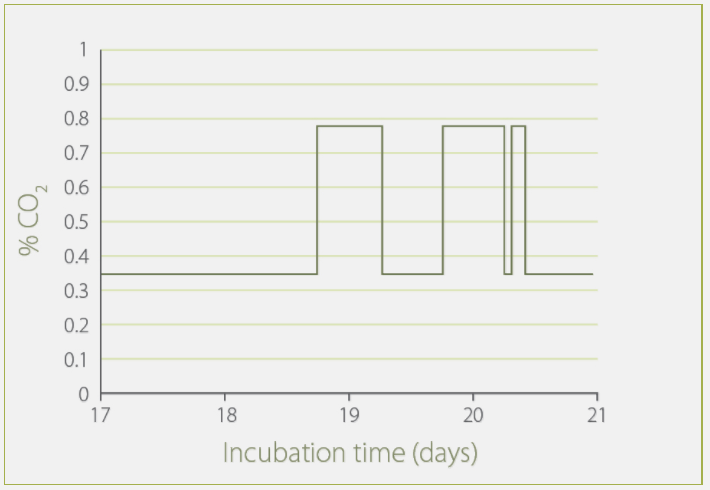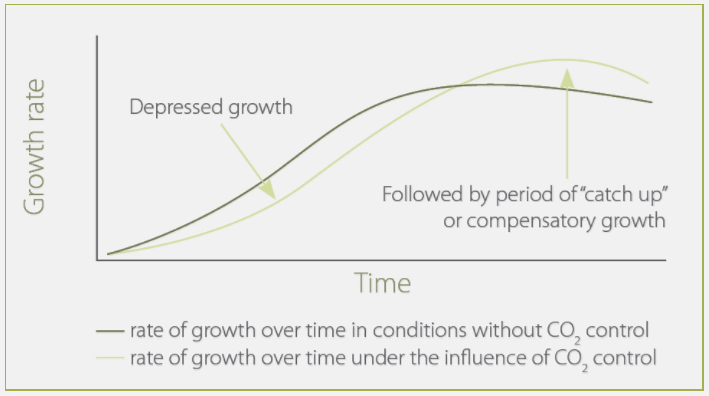



Why and when CO2 levels should be raised or lowered
Today we explain why the levels of CO2 should vary in line with the developmental stages the embryos are in.Why and when should CO2 levels be raised or lowered
Gas exchange is of paramount importance for the embryo to survive. Oxygen (O2), necessary to drive its metabolism, diffuses into the egg through pores in the shell and the produced metabolic carbon dioxide (CO2) diffuses out of the egg along the reverse pathway. Gases are exchanged between embryo and the environment through the pores of the egg shell.
The level of O2 is directly related to the level of CO2. Control systems in incubators will monitor the level of CO2 in the incubator rather than the O2 level since it is easier to measure. Why does controlling the CO2 levels during the entire incubation cycle have a beneficial effect on the development of the embryo and when should CO2 levels become higher or lower?
Day 1 – 9: high CO2 levels
As described earlier in this series “Optimize your value chain”, a mother hen will brood intensively during the first nine days of incubation, so ventilation around the eggs is low. As a consequence, oxygen levels are low and CO2 in the nest is high. There is a very good reason for the hen to do exactly this, because limiting the amount of oxygen during the early embryonic stage leads to a better development of the chorioallantois (i.e. the vascular membrane), lungs and heart. Compare it to athletes: athletes from mountainous regions have an advantage over athletes living at sea level: they have a better lung capacity and a stronger heart because oxygen levels at high altitude are lower and their body develops to compensate this.
Evolution of CO2 levels in the setter. Initial higher CO2 levels in the setter have a positive impact on the development of the cardiovascular system.
Day 10 – 17: low CO2 levels
After these first nine days of incubation, the embryos require more oxygen to develop and they produce more CO2. An enhanced chorioallantois permits the embryo to extract more oxygen through the egg shell at this stage. The hen will then leave the nest on an increasingly regular basis and go looking for food, allowing the embryos to take up more oxygen through their shell. Likewise, incubators also start ventilating more, giving the embryos access to more oxygen by lowering CO2 levels.
Day 18 – 21: varying CO2 levels
CO2 levels can further impact the hatching process as it can delay or trigger internal and external pipping. Therefore, CO2 levels can be adapted to accelerate or slow down certain phases in the hatching cycles, resulting in significant gains in hatch timing and chick uniformity.
Evolution of CO2 levels in the hatcher that lead to significant gains in hatch timing and chick uniformity.
Boosting growth by controlling CO2 levels
Field results of CO2 control
The graph indicates that initial higher CO2 levels slow down growth during the first days after hatch. Energy is then mainly spent on the growth of the chick’s organs. Later, growth gets a strong boost, and eventually exceeds growth of chicks incubated without CO2 control.
Now, are your hatchery and hatchery practices still in great shape? Use the checklist for optimal CO2 regulation.
Checklist for optimum CO2 conditions
- Are your CO2 sensors clean, so they can measure the levels correctly?
- At high altitude, there is less O2. Therefore, CO2 profiles must be modified for the altitude you are at! Contact Petersime’s Customer Service Centre if you are not sure your CO2 profiles are (still) adapted.











